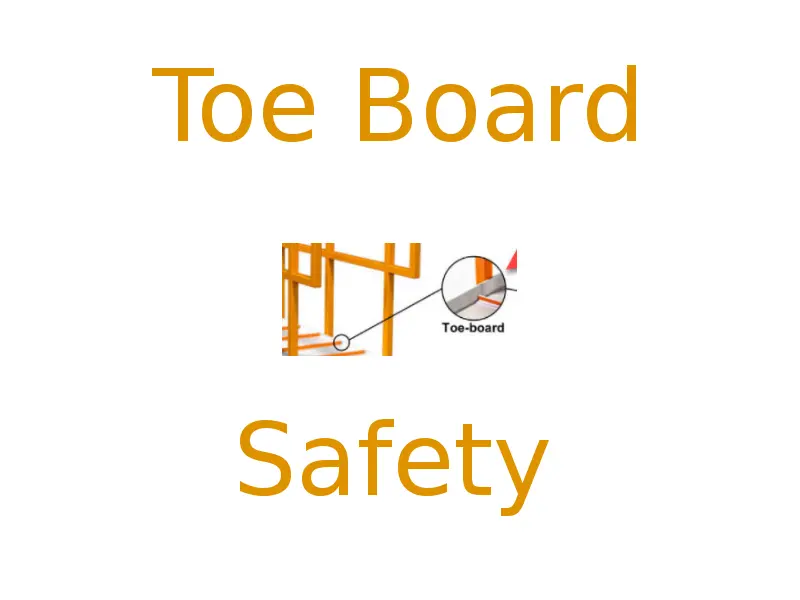Why Should Contractors Install Toe Boards with Railings?

Contractors should always install a toe board when installing a railing, this is to ensure that workers have adequate protection, and aren't injured by falling objects or debris. These things could cause serious injury or even death. The toe board, properly installed, is placed along the edge of a work platform or scaffold in an effort to prevent tools, equipment, and debris from falling to the ground, or perhaps onto workers down below. The railing also provides additional protection by serving as a physical barrier to prevent workers from accidentally stepping off the platform or scaffold. By installing a toe board with each railing you setup, contractors can help reduce the risk of workplace accidents and injuries. It is important to note that installation of the toe board may also qualify as part of the requirements to meet OSHA standards for fall protection in the construction industry.
10 Reasons Contractors Should Install Railings with Toe Boards
- Toe board help to provide a physical barrier in order to prevent objects from falling off the edge of any platforms they protect.
- Toe board can also protects workers or any others below the surface from falling debris, tools, or other materials.
- Prevents injuries or death to those working below, by placing a barrier/obstacle that prevents them from walking or falling off the side of the platform.
- Toe board helps can serve to maintain a clean and organized work area.
- Toe board helps to secure equipment and machinery, this reduces risk of equipment malfunction.
- Prevents trip hazards. A consistent barrier to the edge of any platform prevents workers or persons from falling from a height.
- Do so, complies with OSHA regulations and standards related to fall protection safety.
- Additional support to handrails and guardrails. Makes other guardrails more secure and stable.
- Increases the longevity of the platform.
- Aesthetically they can enhance the visual appearance of the platform by providing a uniform, finished look, which many find more appealing the the without.
Does OSHA Say Contractors Should Install A Toe Board On Railings?
Contractors double check the followings rules and regulations set forth by OSHA. Below we have organized a short list of possible regulations you may want to reread. These regulations mention safety rules regarding the importance of installing toe boards with each railing, or guardrail. OSHA takes fall prevention and protective safety measures seriously. We encourage you do delve deeper into each OSHA regulations that applies to your specific work. OSHA regs can change or be updated and it is always important to understand the rules when others rely on you for safety. I have taken the liberty of bolding the most obvious regulations below with involve toe boards, and may better explain why a contractor should install a toe board when installing railings, from a regulatory standpoint at the least.
- OSHA Standard 1910.23(e)(1) - Guarding floor and wall openings and holes.
- OSHA Standard 1910.23(e)(3) - Providing toe boards for floor openings and holes.
- OSHA Standard 1910.29(b) - Guardrail and handrail specifications.
- OSHA Standard 1910.28(b)(5) - Fixed ladders requiring a cage, well, or ladder safety device.
- OSHA Standard 1910.29(f)(1) - Handrail height requirements.
- OSHA Standard 1910.29(f)(2) - Guardrail height requirements.
- OSHA Standard 1910.29(f)(3) - Midrails, screens, mesh, intermediate vertical members, solid panels, and drive screens.
- OSHA Standard 1910.29(f)(6) - Toe board requirements.
- OSHA Standard 1910.29(f)(7) - Edge protection requirements.
- OSHA Standard 1910.29(j) - Load capacity of handrails and guardrails.
When Are Toe-Boards an OSHA Requirement on Guard Railings?
8 Accidents Installing Toe Boards on Railings Prevents!
- Workers (or anyone for that matter) may fall off the edge of the platform. This could result in serious injury or death.
- Falling hazards: Debris, tools, or other materials may fall and injure or damage those found below.
- Instability of equipment: Equipment & Machinery may become unstable, accidentally causing it to fall off the platform, and damage or injury could ensue.
- Tripping Hazards: Workers may trip over the edge of the platform and fall completely off, obvious injury could occur.
- Scattered materials laying about may create trip hazards and increase risk of falls.
- Guardrails may become unstable and fail, risking a falling accident.
- Slipping on wet or slippery surfaces, and falling off the platform.
- Anyone, especially workers, may suffer from cuts or lacerations from sharp edges found on the surface of the platform.
